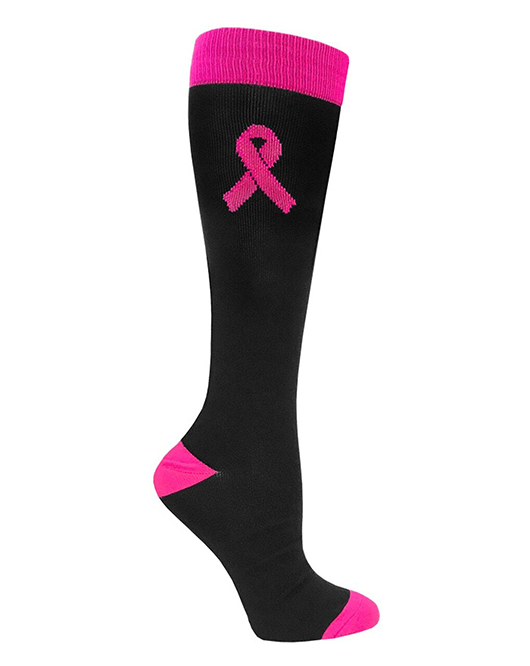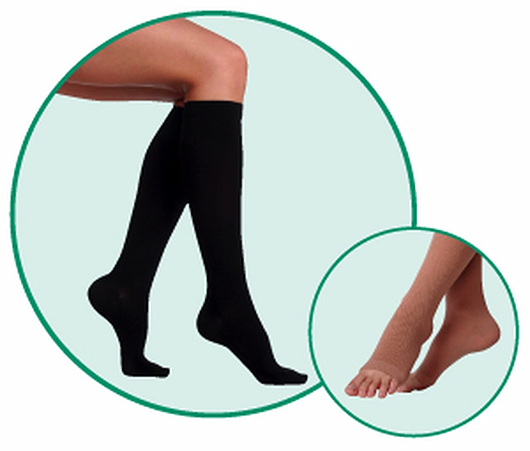Wearing Compression Stockings After Surgery: Everything You Need to Know
Feb 27th, 2021
Recovering from breast cancer surgery takes time, and immediately following treatment, you’ll need to rest and avoid as much movement as possible. Being stationary can wreak havoc on your body from head to toe, even for a short time. One way to counter the adverse effects is by wearing compression stockings after surgery.

You may be wondering how wearing stockings on your legs is beneficial to your breast recovery after surgery.
Compression socks and stockings activate and enhance drainage from the lymphatic system, which is responsible for promoting a healthy immune response and transporting cellular waste around the body. Unlike the cardiovascular system, there is no central pump to transport lymph fluid, so the lymphatic system relies on muscle movement and valves. When you are sedentary, your body can no longer effectively eliminate lymph which can pool in the extremities, such as your legs and feet, which can have a host of adverse health effects.
Whether you’re preparing for a mastectomy, lumpectomy, or breast reconstruction surgery or are starting on the recovery process, your doctor may recommend wearing compression stockings to help promote a faster recovery. Here is everything you need to know to get started.
What are Compression Stockings
Compression stockings are specially designed socks for providing consistent, gentle pressure to your lower legs to maintain healthy blood and lymph flow and reduce the chance of swelling. Graduated compression stockings start tighter at the ankles and slightly loosen as they make their way up your leg.
These compression stockings are for times when your movement is restricted and can be an important part of your overall recovery. They come in knee-high, thigh-high, and full pantyhose styles. If swelling is confined to your lower legs, the knee-high versions are a good choice. If you need a bigger boost in circulation, the thigh-high or pantyhose styles are ideal.

The Juzo Soft Stockings come in both knee-high and thigh-high styles to suit your needs. Made of a soothingly soft material with beaded silicone border to hold the stocking in place, you can wear these stockings all day in comfort, knowing they are also keeping you safe.
Compression stockings aren’t limited to only those recovering from surgery, however. Athletes commonly wear them to facilitate faster post-workout recovery and to prevent injury. Nurses and others on their feet for several hours at a time wear them as a preventive measure and alleviate heaviness in their legs at the end of their shift.
What are the Benefits of Wearing Compression Stockings?
There are several benefits of wearing compression stockings, including the following:
Promotes Blood Circulation
Following surgery, your movement will be restricted so your body can begin to heal. Being stationary, however, can also interrupt your circulation and increase the risk of blood clots. The graduated compression stockings keep your blood flowing in a more natural rhythm and prevent blood clots from forming.
Counters Lymphedema
Women undergoing breast cancer surgery often experience lymphedema. The removal of breast tissue or the lymph nodes puts you more at risk for this side effect. Lymphedema is a condition where excessive lymph fluid builds up, limiting its pathogen removal capabilities and cellular debris from your body. This build-up commonly occurs in the legs, causing swelling, infection, inflammation, and various skin conditions.
Reduces Excessive Swelling
Swelling in the lower legs is often present after surgery but shouldn’t be excessive. By wearing compression socks, this swelling can be minimized. The compression keeps the skin from expanding, requiring excess fluid to spread out instead of pooling, reducing swelling overall.
Decreases Deep Vein Thrombosis Risk (DVT)
Post-surgery, you are at risk of developing DVT or deep vein thrombosis. DVT is caused by blood clots in the legs. These blood clots can break apart and travel throughout the body, eventually blocking blood vessels. These blockages are called embolisms and can be dangerous, particularly a pulmonary embolism.
To reduce the risk of development, compression is applied to the lower legs to encourage regular blood flow and resist accumulation. In turn, your veins return blood to your heart, preventing clotting and swelling.
Helps Prevent Development of Varicose and Spider Veins
Poor circulation can result in the development of spider and varicose veins. As veins flow upward, they can become blocked, leading to a bulging and darkening and potentially causing pain and achiness in your legs.
Speeds Up the Recovery Process
Blood is responsible for carrying the amounts of oxygen and nutrients your body needs to function. It also helps the healing process and speeds up post-surgical wound healing.
How Do Compression Stockings Work?
By exerting consistent, gentle graduated pressure, the diameter of the veins in your legs is reduced, causing blood to flow swiftly. This prevents the accumulation of blood or lymph fluid in the area and instead returns blood to the heart.
Graduated compression socks come in different pressure levels, with the most common being 8-15 mmHg for mild compression and 15-20 mmHg for moderate compression. For anyone at risk of developing lymphedema or varicose veins, a firmer pressure level may be prescribed by your doctor. These include 20-30 mmHg for firm compression, 30-40 mmHg for extra firm compression, and the highest level is 40-50 mmHg, which is typically only available with a prescription.
It’s imperative you have the correct fit for compression stockings. If they are too loose, you’ll receive less benefit. Too tight, and the stockings can cause more damage than benefit, cutting off your circulation and increasing symptoms.
How Long Do You Wear Compression Stockings?
While your doctor may prescribe the required time to wear your compression socks after surgery, it can be anywhere from five days to three months in most cases.
It’s not typically recommended, however, to wear compression stockings at night time while sleeping. This is because lying prone affects blood circulation differently than when upright during the day. When you awake the next morning, put them back on.
Final Thoughts
While your recovery won’t happen overnight, wearing compression stockings can help you get there faster following your breast cancer surgery. Mastectomyshop.com offers a range of stockings and other compression garments online. If you need help selecting the right ones for your circumstances or need answers to questions, call (877) 513-2272 and speak with one of our knowledgeable staff members.
